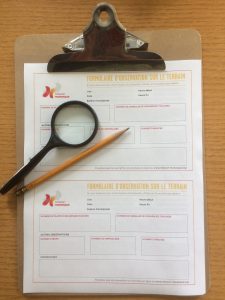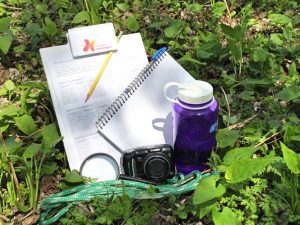
In the field, you will need:
- the field observation form;
- pencils and a hard surface to write on, or a mobile device with wifi, and
- sunscreen and a bottle of water!
To facilitate observation, you may also bring:
- a magnifying glass;
- monarch and milkweed identification sheets;
- the commonly confused species identification sheet;
- the guide to other species living on milkweed;
- a notebook to compile observations and questions, and
- a camera! You can validate your observations and share them in the photo gallery on the website.
A few tips
Take the time to look closely

Monarchs are very good at hiding. Check every leaf (underneath and on top!), flower and fruit on the milkweed plant for eggs and caterpillars. You don’t want to miss anything!
Make sure you count the right thing!
It’s not always easy to recognize a monarch egg or to distinguish between the different larval instars! Even the most experienced observers can make mistakes. So take the time to look closely at the specimens you find, and don’t hesitate to take photos to confirm your identifications. Remember that other species of insects, as well as their caterpillars, also live on milkweed plants.
What if it rains?
Rain doesn’t have to keep you from going out, if you feel like it. Caterpillars will be there, rain or shine! If it is raining on the day of your excursion, you will find a raincoat, boots and a large plastic bag (to protect your data collection sheets) handy. Of course, you can always postpone your outing to the next day if the weather is really unpleasant.
Details regarding the mission
When should I start and finish making my observations? How often should I visit my site?
Monarchs start arriving in Canada in June and the last members of the migratory generation leave in September or October. The ideal is to visit the same site once a week, on the same day and at the same time, from June to September. The more regularly you collect your data, the more reliable they will be. If you can manage it, that’s great! If you can’t be that consistent, don’t worry, all data are useful. We want to know what’s happening on your site, and if you can visit it at least four times over the summer, that will give us a good idea.
What if there is more than one milkweed species on my site?
Use one data collection sheet per milkweed species present. So you’ll be following the same instructions, but recording your data on two separate sheets.
How many milkweed plants can I look at?
There is not really any minimum or maximum. If you’re able to examine all the milkweed plants on your site, go ahead! If there are too many plants to inspect them all, a 20-plant sample (chosen according to the protocol) is sufficient.
Is there a maximum number of observations/outings I can make?
The idea is to visit a site once a week and to examine up to 80 milkweed plants. Collecting more data on a given site won’t add any especially useful information. If you want to keep going, it’s better to add a new site and conduct a count there.
What if I can’t find any monarchs on my site?
You’ll likely get mostly zeros – which means that you’ll find very few, if any monarchs. That’s ok. Keep going with your observations. It is just as important to know where there aren’t any monarchs as where they are found. And who knows, you may be surprised sometime over the summer to see a female preparing to lay her eggs on the milkweed on your site!
What if my site gets mowed during the summer?
Unfortunately, there’s not much you can do. Make a note of it and submit your observations to the Mission Monarch website. You can go back a few weeks later, though, and look for some new milkweed shoots. You might even find some monarch eggs on small milkweed shoots.
How can I identify the boundaries of my site?
Your observation site is the entire area in which milkweed could grow. Milkweed is usually found in open, disturbed sites, like fields. Wooded areas, roads and the edges of lawns are examples of changes in habitat. They may help you identify the boundaries of your site. On your first visit, look around your site and pick out some landmarks to help you mark your observations on the interactive map when you submit your data.
Can my observation site be my garden?
Yes. Even better, you can maximize your chances of observing monarchs by turning your garden into a monarch oasis.

